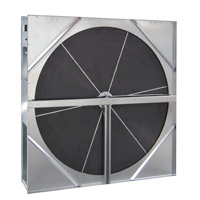
Thermal wheel technology is an energy efficient solution
In the current climate of stringent building regulations, ever-tightening standards in building service provisions and the ever-increasing pressure on environmental issues; Thermal wheel technology may never have been of greater significance.
Thermal wheels are now being used as a leading component in support of the trend to use heat recovery as a route to energy savings.
Thermal wheel technology has the capacity to turn a standard efficiency air handling unit into a very high efficiency one
Why? Thermal wheel technology has the capacity to significantly increase the efficiency of AHUs.
Furthermore, the wheels can recover around 85% of heat from ventilation air.
It transfers this into incoming fresh air, which then needs minimal additional heating to reach the required temperature for the building.
Considering the large amount of legislation surrounding energy efficiency and carbon emissions reduction for heating equipment, it would be a surprise if an AHU could be fully compliant without some form of heat recovery capacity.
Thermal wheels do the job more efficiently than most, and can have a significant positive impact on carbon footprint and fuel costs.
How do thermal wheels work?
Thermal wheels work through a process known as regenerative heat transfer.
The thermal wheel is constructed from a very thin aluminium sheet, wound in alternating flat and corrugated layers, forming a strong, rigid matrix containing thousands of small air passages.
Warm exhaust air passes through these passages as it rotates and a large percentage of heat from the air is absorbed by the aluminium.
As the matrix moves into the fresh air flow the absorption process is reversed.
The cooler incoming air flows over both sides of the aluminium wheel and through the narrow channels where it absorbs heat given from the matrix.
The thermal wheel also allows the transfer of moisture from exhaust air to the incoming air.
This is important in air-conditioned premises where the humidity of the internal air is controlled. It is just as effective for applications where recovery of cooling energy is required, such as when permanent cooling is necessary.
Environmentally advantageous
While the energy efficiency of thermal wheels with AHUs is well established, they provide many other benefits for the environment.
The thermal wheel’s small footprint allows the size of the AHU to be reduced by up to two metres, cutting capital expenditure and increasing the pay-back period.
Furthermore, thermal wheels also reduce the size of the heating/cooling coil, therefore allowing a reduced capacity boiler or cooling condenser to be fitted.
The use of thermal wheels in AHUs is very versatile.
For instance, they have been successfully used in aggressive environments such as paint spray plants – and due to the robust nature of the aluminium matrix, the wheel maintains its peak efficiency during its long operational life.
Thermal wheels suffer little wear during their lifetime, and the aluminium is recyclable at the end of its working life.
New developments
Despite the thermal wheel being a well established technology, there have been recent innovations to advance its applications even further.
With the addition of a sorption coating for instance, specialist wheels can significantly reduce the size of a chiller plant for carbon and capital savings whilst benefitting from superior temperature and humidity transfer.
While the quest for economic methods of reducing our carbon footprint continues, thermal wheel’s highly efficient and versatile method of heat recovery in AHUs adds another positive step forward in the process.
Latest news

22nd November 2024
Insight Data: Using Marketing Data to Build a Successful Business in 2025
Alex Tremlett, Insight Data’s Commercial Director, discusses the challenges for construction firms in 2025 and shares six strategies for success…
Posted in Articles, Building Industry News, Building Services, Information Technology, news, Research & Materials Testing
22nd November 2024
Purplex: A tough Budget, but opportunity still knocks
Incoming governments, especially those with significant mandates, inevitably come into power on a tidal wave of optimism coupled with hope that ‘Things can only get better’. Andrew Scott, MD of construction-focused, full-service agency Purplex, talks…
Posted in Articles, Building Industry News, Building Services, Information Technology, news, Posts, Research & Materials Testing
22nd November 2024
Pop Up Power Supplies Gets Arty in Yorkshire
Pop Up Power Supplies has installed 13 new electricity units at The Hepworth Wakefield – read more in this article…
Posted in Articles, Building Industry News, Building Products & Structures, Building Services, Case Studies, Civil Engineering, Facility Management & Building Services, Garden, Hard Landscaping & Walkways, Landscaping, Posts, Restoration & Refurbishment, Retrofit & Renovation
22nd November 2024
OPT Services Revolutionises Fibre Cable Capping with Eco-Friendly Innovation
UK-based OPT Services has unveiled SlimLine™ Capping, a groundbreaking fibre cable protection solution that promises to deliver significant environmental and installation advantages to the fibre optic industry.
Posted in Articles, Building Industry News, Building Products & Structures, Building Services, Facility Management & Building Services, Information Technology, Innovations & New Products, Sustainability & Energy Efficiency
 Sign up:
Sign up: